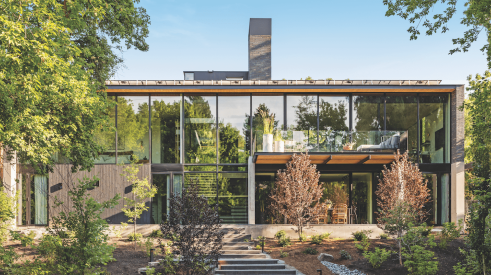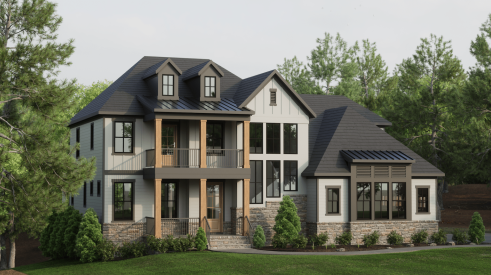Builders are often thought to be resistant to new methods and slow to change. This is both true and unfortunate, because the legitimate reasons for their attitude are often ignored. For every new product or technology that comes along, there are several reasons to be wary. From product defect to consumer resistance to litigation, builders are more than justified in their hesitation.
Those who have been burned by so-called "improvements" in the past, or those who prefer to wait until a new technology or technique is time-tested and proven can now take heart; there are now a multitude of organizations taking the risks on their behalf. Government and private groups, agencies and consortiums, along with manufacturers, universities and builders are erecting demonstration homes which test new ideas and methods and quantify the results.
Perhaps the biggest player in the new technology testing game is the Partnership for Advancing Technology in Housing (PATH). From providing builders both big and small with technical information on innovative technology to showcasing demonstration projects around the country, PATH has been instrumental in finding new ways to improve our nation’s housing.
"PATH’s goals - improving the affordability, energy efficiency, durability and environmental performance of our nation’s housing - reflect where the U.S. housing industry is headed," says Elizabeth Burdock, executive director of PATH.
The PATH program acts as an umbrella initiative, linking federal agencies, builders, manufacturers, insurance, financial and regulatory groups under one shroud of housing innovation. The U.S. Departments of Agriculture, Commerce, Energy, and Labor, along with the Andersen Corp., Carrier Corp., Lucent Technologies, Centex Homes and Pulte Corp. are but a few of these many groups.
PATH promotes cooperative and focused research among these groups and tackles barriers to innovation - from risk and liability concerns to consistent manufacturing processes to quantitative testing and evaluation systems - then showcases the results in "concept homes" around the country. It is a massive undertaking with ambitious goals:
The U.S. Department of Energy’s Building America Program is one large group playing a major role in achieving these goals. This program focuses mainly on reducing energy use, construction time and construction waste through a systems engineering approach.
Program Manager George James explains that by viewing the entire house--from the ground up--as an integrated system of components, it becomes clearer how improvements to one component can greatly effect the efficiency of others.
"We look at the house as a whole system and incorporate improvements that all together yield optimal performance, quality and energy and cost savings," says James.
The program has devised techniques to tighten the building envelope which enables builders to install smaller, more efficient and less expensive HVAC units. These savings can then be reinvested in high-performance windows that further reduce energy use and utility costs. Systems trade-offs such as these improve performance without affecting the costs to either builders or buyers.
"The lure of lower utility bills can be a powerful sales tool to entice buyers to purchase more options or upgrades, or perhaps even allow them to purchase a home they could not have afforded otherwise," says James. Building America itself has many internal programs working to perfect newer building methods such as structural insulated panels, precast concrete foundations, low-loss air ducts, programmable zoned ventilation and several others in their own concept homes.
These concept homes also address another problem builders often face with new technologies--resistance from insurance carriers and code enforcement agencies. These homes assuage the fears some of these agencies may have by proving they do indeed work, and work well.
"Inspection during construction has been a barrier to acceptance for some of these technologies," says James. "We have been working on a standard certification process and quality control issues, and we’re really beginning to bring things up to speed."
With these governing bodies now able to see the technologies in action, their resistance is beginning to wane. James is currently trying to get some communities to certify all the houses in a community simply by sampling one out of every seven homes.
"These field workshops are not only for other builders, they are for the insurers and code enforcers as well," says James. "We want to show everyone how it can be done."
While many of the partnerships and initiatives have been conducted with large-volume production builders, James says that Building America, PATH and the various other groups are reaching out to small-volume builders and the manufactured housing sectors.
"As these newer techniques become more cost-effective, we want everyone to be able to use them," says James. "We don’t want acceptance or price-point to be a factor anymore."
Manufactured housing has itself become an answer of sorts to some of the problems these initiatives are addressing. With their systems engineering principle and panelized construction process, manufactured housing has long been addressing labor, construction and energy efficiency issues. "The increased use and popularity of manufactured housing is very encouraging," says James. "These homes are continually improving in quality and we are learning new techniques from them as well."
The housing industry is still extremely fragmented, even in the current climate of big mergers. And with technology moving at an ever-increasing pace, the goals of PATH and their partners may seem overly ambitious--if not unreachable. However, with the sheer number of people in these programs working toward a common goal, Elizabeth Burdock of PATH is confident of their success.
"By working together with the industry and the Federal government to move advanced housing technologies into the marketplace at a faster pace, we will meet our goals by 2010--and change the way Americans think about and build housing," says Burdock.
Also See:
Building Tomorrow's Housing Today
Advertisement
Related Stories
Design
2023 BALA Winners: The Best of the Best
You'll find plenty of inspiration in these four award-winning projects from the Best in American Living Awards
Design
What Gen-Z Buyers Really Want in a Home
The fervor of planning for Millennials in the home building industry has now pivoted to Gen Z. So, what does this new generation want?
Design
4 Luxury Production Home Designs to Inspire
Yes, these are designs for production homes, but you won't find any cookie-cutter repetitive elements in this high-end selection






